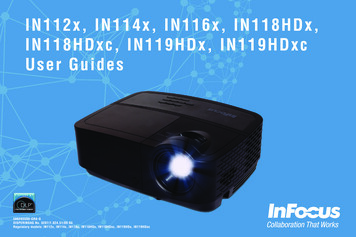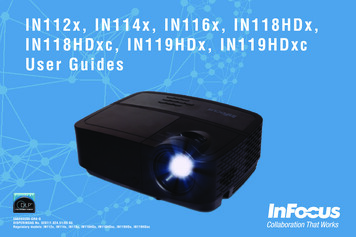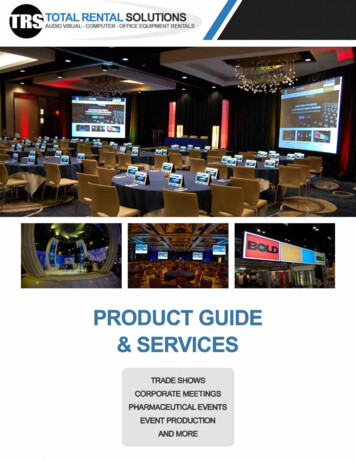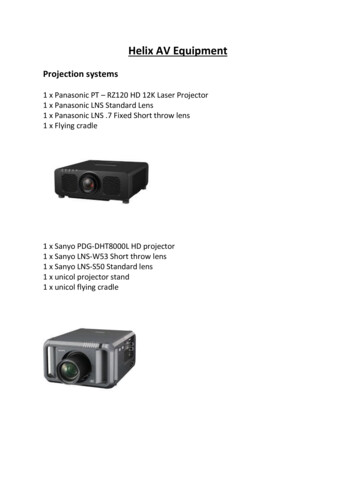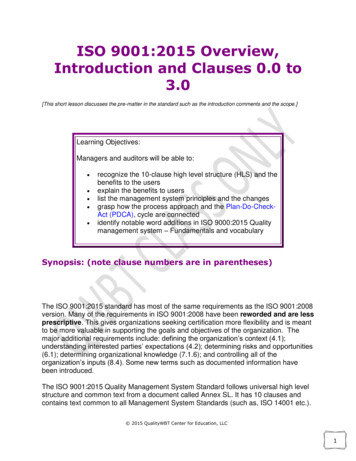
Transcription
An Introduction to MIDI 2006, 2009 Roland Corporation U.S., 2009 MIDI Manufacturers AssociationAll rights reserved. No part of this publication may be reproduced in any form without thewritten permisssion of Roland Corporation U.S. and the MIDI Manufacturers Association.1
About This BookletThis booklet provides important basic background information that canhelp you get the most out of your MIDI products.While there’s always plenty to say about any one instrument, there are sometopics that apply to a wide range of instruments.For information about a specific product, please check out the websites ofthe individual companies that make MIDI equipment.Electronic musical instruments offer an incredible array of sounds toprofessional and amateur musicians. They place at a musician’s fingertipseverything from traditional, real-world sounds to noises that have neverbeen heard before.Understanding the Symbols in This BookletThroughout this booklet, you’ll come across information that deservesspecial attention—that’s the reason it’s labeled with one of the followingsymbols.A note is something that adds information about the topic at hand.A tip offers suggestions for using the feature being discussed.Warnings contain important information that can help you avoidpossible damage to your equipment, your data, or yourself.They come in all shapes and sizes, too, from solid, physical instruments suchas keyboards, beat boxes, and electronic drum kits, to computer-based“virtual” instruments, or “soft synths.”Understanding MIDIWhat MIDI Isn’tYes, it’s an odd place to start, but one of the things that confuses people newto MIDI is that they assume MIDI is some type of sound, or audio, that travelsthrough MIDI cables. It’s not.What MIDI IsAll of these devices rely on something called “MIDI.” You really can’t get toofar with an electronic instrument without bumping into MIDI. This is actuallya good thing, though, since MIDI allows you to do all sorts of excitingmusical things.MIDI, which stands for “Musical Instrument Digital Interface,” is a system thatallows electronic musical instruments and computers to send instructionsto each other. It sounds simple, but MIDI provides some profound creativeopportunities.Of course, it helps to know what MIDI is—that’s what this booklet’s for. Onceyou understand the basics, you can consult the documentation for yourdevice to learn more about how it uses MIDI.2
Why MIDI MattersHere are just some of the things MIDI makes possible: You can use a MIDI instrument with which you’re comfortable to playthe sounds belonging to any other MIDI device, including soft synths. Create rich musical textures by layering sounds from multiple MIDIdevices, or assign different sounds to play in different pitch ranges. When you play a MIDI instrument, it produces data that can be capturedby a MIDI “sequencer.” When the sequencer plays back the data,your original performance is recreated. Sequencers aren’t just MIDIrecorders, though—they let you fix mistakes, change the pitches ofyour notes, fix their timing, the way they play, the sounds they use, andmore. In addition, most sequencers can capture multiple performanceson separate “tracks,” allowing you to build up full musical arrangements,one track at a time. The General MIDI sound set allows you to instantly play back prerecorded music on many MIDI instruments, or on a computer. One MIDI device can control another, letting you use the most convenienttool for any job. Edit MIDI instrument sounds on your computer, operatean audio recorder from a MIDI beat box, and on and on.When you hold down the Middle C on the keyboard, the keyboard sendsout a Middle C “key down” MIDI message to the module. The module says toitself, “Ah, right, Middle C,” and plays Middle C.Middle CWhen you let go of Middle C, the keyboard sends a Middle C “note off”message to the module, and the module stops playing its Middle C note.Note-on and note-off messages are just the beginning, though. Most MIDIcontrollers can also sense how hard you play a note, transmitting a MIDI“velocity” value to the receiving device so the volume or brightness of itsnote responds to your touch.And, of course, you’ll usually play more than one note at a time.We’ll discuss other types of MIDI messages a bit later, and explain howthey’re put together.We’ll discuss all of these things later in this booklet.A World of MIDI ControllersWhat MIDI DoesWhen one MIDI device communicates with another, it’s all about instructions:It’s just one MIDI device telling another one what to do. Here’s how playinga note—the most common MIDI activity—happens.Suppose you’ve got a MIDI keyboard connected to a MIDI synthesizer box, or“module,” and you want to play the module from the keyboard.A MIDI device that controls another is referred to as a MIDI “controller.”Though most people think of MIDI as being just for keyboard players, a widerange of MIDI controllers and control surfaces make it easy for all sorts ofplayers and engineers to harness the power of MIDI.Let’s talk about some of the available controllers just to give you some ideaof the possibilities.3
Guitar ControllersA steel-stringed guitar with a MIDI pickup or a dedicated MIDI guitarsynthesizer can turn a guitar into a full-fledged MIDI controllerof exceptional expressiveness.Other ControllersThere are a number of other instruments and devices that use MIDI. Thereare specially made MIDI wind controllers, mallet controllers, and evenMIDI accordions. Since MIDI was primarily designed for keyboard players,these devices are often referred to as "alternate controllers".Another category of alternate MIDI controllers are those that don't mirrortraditional musical instruments. These are simple switches and controls thatcan be used in items as various as clothing (gloves, suites, mats), to objectsthat can be hit, strummed, blown, or even controlled by a light beam.Whether you’re playing the guitar synth’s own sounds or external MIDIsounds, standard guitar techniques can make MIDI sounds come alive.MIDI devices can not only be used to trigger note information, but they canalso send control information to other devices, such as lighting controllers.The Power of MIDI SequencersDrum ControllersElectronic drum sets offer a totally natural playing experience along withincredible sounds, all without the hassles of a traditional kit. You canpractice on headphones all night if you want, or record drum tracks straightinto a MIDI sequencer from a drum kit’s pad and cymbal controllers.There are smaller drum controllers you can play withsticks, or even with your hands. You can also controlMIDI devices from traditional acoustic drums by installingMIDI drum triggers.A MIDI sequencer can provide a tremendous amount of fun for the amateurmusician, and it’s a powerful tool in the hands of a professional. In fact,sequencers play an important role in many modern commercial recordings.During recording, the sequencer captures and plays back live MIDIperformances. Performances can also be constructed slowly, note-by-note,using a variety of methods that may include “step sequencing” and onscreenpencil tools that let you “draw” the notes you want.Each recorded performance is typically stored on its own track, and asequencer may offer anywhere from 16 tracks to over a hundred.Remember, too, that a captured MIDI performance is just a set ofinstructions for recreating the performance. Since it doesn’t containany actual sound, you can choose the best sound for a performanceeven after it’s been recorded.4
A sequencer may let you view notes in an variety of ways, from a list of MIDIevents, to a piano-roll-type view, to onscreen notation. (Many sequencersalso allow you to print the notation you see onscreen.)products’ features, resulting in files that only their sequencers can play. Thispresents a roadblock for musicians who want to collaborate or otherwiseshare sequencer files.The capturing of MIDI notes is just the beginning, since a sequencer allowsyou to do all sorts of things to perfect your music. Some of the mostcommonly used sequencer tools are:The solution is the Standard MIDI File, or “SMF,” format.This standardized sequence file format allows music totravel from one sequencer to another, since most modernsequencers can play SMFs, and store songs as SMFs. AnSMF may not contain all of the bells and whistles thatmake any one sequencer unique, but it supports thefeatures that are common to all sequencers, and thismakes them extremely handy. All SMF files have“.mid” at the end oftheir name.quantization—that corrects the timing of notes.transposition—that moves notes to new musical keys.scaling—that changes the feel of recorded musical phrases by adjustingrecorded velocity values, note lengths, and more.Some instruments contain a built-in sequencer, giving you sounds andsequencing in a single “workstation.” There are also numerous computerbased sequencing programs and standalone hardware sequencers.Two Types of SMFsSMFs come in two flavors: Type 0 SMFs—contain a single sequencer track that holds recordedperformances for up to 16 different sounds. Type 1 SMFs—can contain multiple sequencer tracks.MIDI and VideoSome sequencers can record audio in addition to MIDI, allowing you to workon all of the elements in a song at the same time. Some MIDI instrumentsalso provide this capability, as do computer-based sequencing programscalled “DAWs,” an acronym for “Digital Audio Workstations.”Standard MIDI Files, or “SMFs”Whether a sequencer’s in a workstation, on a computer, or a standalonedevice, each song’s data has to be stored as a file somewhere, somehow.Each manufacturer has their own type of sequencer file that works for theirMIDI doesn’t have to be simply aboutmusic. Some MIDI devices allowperformers—called “VJs”—to manipulatevideo images onstage, creating excitingvisuals. Special software on a laptopcomputer along with DJ-style physicalcontrols open up a world of videopossibilities, letting VJs remotely selectclips and control how they behave.Also, some keyboards have a button that, when pressed, instantlyreconfigures the keyboard’s knobs, sliders, and buttons ascontrollers for an attached video playback system.5
General MIDI and General MIDI 2General MIDI, or “GM,” is very specific set of standards thatallows MIDI composers and arrangers to create music thatalways plays correctly on any device that supports GeneralMIDI.Why Do We Need GM?MIDI instruments store their sounds in numbered memory locations,and each manufacturer can use any location for any sound. However,if a composer’s MIDI recording is played by someone who has differentequipment, there’s no way for the composer to know where the requiredsounds are.The GM SolutionGeneral MIDI solves this since all General MIDI devices contain the same setof 128 standard sounds and drum kit sounds, stored in a specified order.Each product creates these sounds using its own unique capabilities, but thegoal is to have them all sound similar enough when playing back GM data.The General MIDI sounds originally came from Roland’s SoundCanvassound module. These sounds did such a good job of meeting musicians’needs they became the foundation of the General MIDI standard.Instruments that support GM may also have lots of other soundsstored elsewhere in their memories, but these sounds can’t be used inGeneral MIDI recordings.General MIDI also specifies certain MIDI messages for controlling thebehavior of sounds and effects.GM recordings are always SMF files.What GM Makes PossibleThere are lots of GM recordings on the Internet, and you can also purchasethem from a variety of sources. These easy-to-use files can be great forsinging or playing along with, allowing you to enjoy MIDI music withouthaving to deal with any of its complexities.Most computers ship with a set of General MIDI sounds, and some computergames use them. Often, all you need to do is double-click a GM file and hitPlay on a computer. GM-enabled MIDI instruments may also require little orno effort on the user’s part— you often simply select a GM song and pressPLAY.General MIDI 2General MIDI 2 includes everything in General MIDI 1,adding more sounds, standards for sound editing, andsome other niceties. If a device supports GM 2, it sportsthe GM 2 logo.MIDI ConnectionsMIDI CablesMIDI devices are typically connected to each other usingMIDI cables. All MIDI cables use the same wiring and havethe same type of 5-pin-DIN-type connector on each end.A MIDI cable’sconnectorSome instruments offer MIDI communication with a computer using astandard USB cable instead of a MIDI cable, as we’ll see.Many instruments also use MIDI on the inside as a way for one internalcomponent to talk to another. These private conversations happenunder-the-hood, using internal MIDI wiring you obviously don’t see.6
MIDI ChannelsA single MIDI connection can carry 16 independent streams, or “channels,” ofMIDI information. The ability to have 16 separate MIDI conversations goingon at the same time allows a couple of important things.One MIDI Device Can Control All of Your Other MIDI DevicesBy setting up each MIDI device to listen only to MIDI instructions on aparticular MIDI channel, you can control a whole roomful of MIDI devicesfrom a single central MIDI device, such as a controller or a computer.Channel 16’sMIDI DeviceChannel 1’sMIDI DeviceChannel 2’sMIDI DeviceChannel 15’sMIDI DeviceChannel 14’sMIDI DeviceChannel 4’sMIDI DeviceChannel 12’sMIDI DeviceChannel 5’sMIDI DeviceChannel 11’sMIDI DeviceChannel 6’sMIDI DeviceChannel 10’sMIDI DeviceMIDI Channel 5UltimatGrandMIDI Channel 9Stage EPMIDI Channel 13Purple OrganMIDI Channel 2Full StringsMIDI Channel 6Strat GtrMIDI Channel 10Rock Kit 1MIDI Channel 14Epic LeadMIDI Channel 3MC-404 BassMIDI Channel 7Wired SynthMIDI Channel 11Dark TrumpetMIDI Channel 15Good Old HitMIDI Channel 4Elec PercMIDI Channel 8DynamicBrassMIDI Channel 12Motion PadMIDI Channel 16Choral SweepMIDI keyboards typically allow
Yes, it’s an odd place to start, but one of the things that confuses people new to MIDI is that they assume MIDI is some type of sound, or audio, that travels through MIDI cables. It’s not. What MIDI Is . MIDI, which stands for “Musical Instrument Digital Interface,” is a system that
